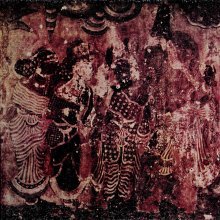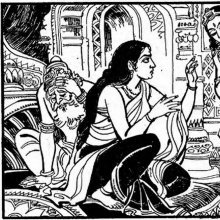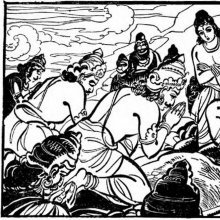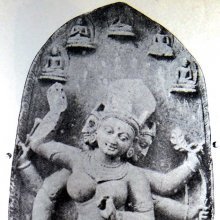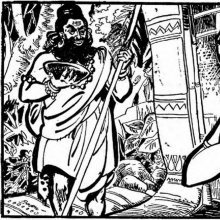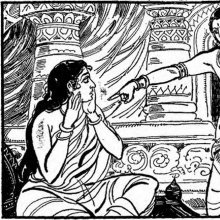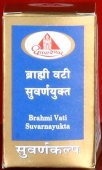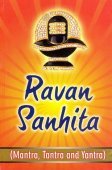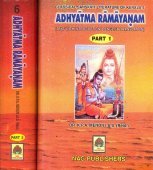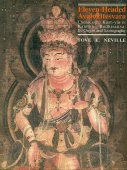Anger, Angry: 7 definitions
Introduction:
Anger means something in Buddhism, Pali, Hinduism, Sanskrit, Jainism, Prakrit, the history of ancient India. If you want to know the exact meaning, history, etymology or English translation of this term then check out the descriptions on this page. Add your comment or reference to a book if you want to contribute to this summary article.
Images (photo gallery)
(+13 more images available)
In Hinduism
Natyashastra (theatrics and dramaturgy)
Source: Shodhganga: Elements of Art and Architecture in the Trtiyakhanda of the Visnudharmottarapurana (natya)1) Anger (expressions) is associated with Kampita: one of the “seven movements of the head” (in Sanskrit Dramas), as conveyed through Āṅgikābhinaya: one of the four divisions of Abhinaya or “ways to convey or represent one’s emotion to others”, according to the Nāṭyaśāstra and the Viṣṇudharmottarapurāṇa, an ancient Sanskrit text which (being encyclopedic in nature) deals with a variety of cultural topics such as arts, architecture, music, grammar and astronomy.—The āṅgikābhinaya includes the histrionic representation of the limbs which is simply known as physical gestures. In the Viṣṇudharmottarapurāṇa, seven types of movements of the head are recorded. Kampita denotes shivering head shows anger, threatening, arguing etc.
2) Walking in Anger is associated with Śīghra-gati: one of the various Gatis (“way of walking”).—Śīghragati or quick gait should be adopted in fear, terror, anger, joy, rapid and urgent actions, on hearing distasteful information, on seeing unbelievable things, searching of crime factors etc. In the Mṛcchakaṭika of Śudraka, the heroin Vasantasenā was moving speedily in terror as she was followed by some cunning persons like Vīṭa, Ceṭa and Śakāra and her gait was crossing over the speed of wind. This can be taken as a manifestation of śīghra-gati.

Natyashastra (नाट्यशास्त्र, nāṭyaśāstra) refers to both the ancient Indian tradition (shastra) of performing arts, (natya—theatrics, drama, dance, music), as well as the name of a Sanskrit work dealing with these subjects. It also teaches the rules for composing Dramatic plays (nataka), construction and performance of Theater, and Poetic works (kavya).
Shilpashastra (iconography)
Source: Shodhganga: Elements of Art and Architecture in the Trtiyakhanda of the Visnudharmottarapurana (shilpa)1) Anger is associated withe the Furious Sentiment (raudra), which refers to one of the Nine Sentiments (citrarasa) in ancient Indian Painting (citra), according to the Viṣṇudharmottarapurāṇa, an ancient Sanskrit text which (being encyclopedic in nature) deals with a variety of cultural topics such as arts, architecture, music, grammar and astronomy.—According to the Viṣṇudharmottarapurāṇa, the raudrarasa is delineated with harshness, passion and anger in a picture. [...] Thus, painting is a medium of showing the inner feelings and emotions of a painter which can strikes the inherent sentiments of connoisseur’s mind, for example: passion in the furious sentiment.
2) Anger is associated with the Eye in the shape of an arrow, which follows specific guidelines of ancient Indian Painting (citra).—In the Viṣṇudharmottarapurāṇa also, different kinds of eyes and their particular shapes are elaborately discussed in the context of Painting. The fifth variety of eye should be in the shape of a śara i.e., an arrow and the measurement should be ten yavas. This kind of eyes should be attached with the portrait of a person who is in anger or pain.

Shilpashastra (शिल्पशास्त्र, śilpaśāstra) represents the ancient Indian science (shastra) of creative arts (shilpa) such as sculpture, iconography and painting. Closely related to Vastushastra (architecture), they often share the same literature.
Yoga (school of philosophy)
Source: ORA: Amanaska (king of all yogas): A Critical Edition and Annotated Translation by Jason BirchAnger is denoted by the Sanskrit term Krodha [kāmakrodhādibandhanam], according to the Amanaska Yoga treatise dealing with meditation, absorption, yogic powers and liberation.—Accordingly, as Īśvara says to Vāmadeva: “[...] As soon as the no-mind [state arises,] the bondage of lust, anger (krodha) and [other such snares] is immediately destroyed. When the [rigid] pillar of mental faculties has ceased [to exist], the bodily abode becomes loose [and collapses]. [...]”.

Yoga is originally considered a branch of Hindu philosophy (astika), but both ancient and modern Yoga combine the physical, mental and spiritual. Yoga teaches various physical techniques also known as āsanas (postures), used for various purposes (eg., meditation, contemplation, relaxation).
Ayurveda (science of life)
Source: International Research Journal of Ayurveda and Yoga: Role of Ayurveda in the Management of Manas Roga (Mental Disorders)Anger is denoted by the Sanskrit term Krodha and refers to one of the negative conditions of modern society.—Mental Health (according to Ayurveda) is brought about essentially as a result of unwholesome interaction between the individual and this environment. Epidemiological studies report prevalence rates for psychiatric disorders varying from 9.5 to 370/1000 population in India. [...]. In today’s metaphysical society, human life has become speedy, mechanized, and less effective and more centred, which contribute to more production of [e.g., Krodha (anger)].

Āyurveda (आयुर्वेद, ayurveda) is a branch of Indian science dealing with medicine, herbalism, taxology, anatomy, surgery, alchemy and related topics. Traditional practice of Āyurveda in ancient India dates back to at least the first millenium BC. Literature is commonly written in Sanskrit using various poetic metres.
In Buddhism
Tibetan Buddhism (Vajrayana or tantric Buddhism)
Source: ORA: Amanaska (king of all yogas): (Tibetan Buddhism)(Being) Angry is denoted by the Sanskrit term Krodha, according to verse 14.24bd-27 of the Laghuśaṃvara, an ancient Buddhist Yoginī Tantra.—Accordingly: “The Sādhaka [who has] the Siddhi of speech can certainly attract a king or queen by [merely] thinking [it]. He quickly controls gods, demons and men. When angry (krodha), he can kill with his speech and drive away his adversary. The practitioner can thus effect a curse with his speech [...]”.

Tibetan Buddhism includes schools such as Nyingma, Kadampa, Kagyu and Gelug. Their primary canon of literature is divided in two broad categories: The Kangyur, which consists of Buddha’s words, and the Tengyur, which includes commentaries from various sources. Esotericism and tantra techniques (vajrayāna) are collected indepently.
In Jainism
General definition (in Jainism)
Source: academia.edu: Tessitori Collection IAnger refers to one of the “thirteen difficulties”, according to the “Teraha kāṭhīyā-svādhyāya” by Jinaharṣa (dealing with the Ethics section of Jain Canonical literature), which is included in the collection of manuscripts at the ‘Vincenzo Joppi’ library, collected by Luigi Pio Tessitori during his visit to Rajasthan between 1914 and 1919.—The exposition of the ‘thirteen difficulties’ [e.g., anger (krodha)] against which one should fight as they are hindrances to proper religious practice is a widespread topic in Jain literature in Gujarati.

Jainism is an Indian religion of Dharma whose doctrine revolves around harmlessness (ahimsa) towards every living being. The two major branches (Digambara and Svetambara) of Jainism stimulate self-control (or, shramana, ‘self-reliance’) and spiritual development through a path of peace for the soul to progess to the ultimate goal.
India history and geography
Source: Singhi Jain Series: Ratnaprabha-suri’s Kuvalayamala-katha (history)Anger was contemplated on as evil, by those pursuing the spiritual life in the Hermitages (or Ashrams) of ancient India, as vividly depicted in the Kathās (narrative poems) such as Uddyotanasūri in his 8th-century Kuvalayamālā (a Prakrit Campū, similar to Kāvya poetry).—Page 87.20-28: Here is a vivid description of the intellectual and spiritual life in the Aśrama of a Jaina Muni. Uddyotanasūri gives a list of twenty-one methods of study and discussions and approaches to the tenets of religion and philosophy, [e.g., condemning the evils of egoism, pride and anger and greed] [...]. Also see the description of the hermitage of Divākara Mitra described by Bāṇa in the Harṣacarita.

The history of India traces the identification of countries, villages, towns and other regions of India, as well as mythology, zoology, royal dynasties, rulers, tribes, local festivities and traditions and regional languages. Ancient India enjoyed religious freedom and encourages the path of Dharma, a concept common to Buddhism, Hinduism, and Jainism.
See also (Relevant definitions)
Ends with: Abandonment of anger, Bee-hanger, Bondage of anger, Byhanger, Danger, Dhanger, Ganger, Kanger, Lauripanger, Manger.
Full-text (+2987): Krodha, Rosa, Kruddha, Kopa, Rosana, Kupita, Sarosha, Rushta, Kopana, Krudh, Kridakopa, Samrambhin, Manyu, Krodhin, Kritakopa, Sakopa, Akrodha, Kilakincita, Krodhana, Vimanyu.
Relevant text
Search found 423 books and stories containing Anger, Angry; (plurals include: Angers, Angries). You can also click to the full overview containing English textual excerpts. Below are direct links for the most relevant articles:
The Book of Protection (by Piyadassi Thera)
Discourse 22 - Discourse On Outcasts < [Discourses]
Discourse 4 - Discourse On Loving-kindness < [Discourses]
Discourse 21 - Discourse On Downfall < [Discourses]
Manusmriti with the Commentary of Medhatithi (by Ganganatha Jha)
Verse 7.27 < [Section II - Punishment (daṇḍa)]
Verse 3.229 < [Section XIV - Method of Feeding]
Verse 3.230 < [Section XIV - Method of Feeding]
The Four Noble Truths (by Ajahn Sumedho)
Part 6 - Insight In Situations < [Chapter 1 - The First Noble Truth]
Part 3 - Morality And Compassion < [Chapter 1 - The First Noble Truth]
Part 1 - Suffering And Self-view < [Chapter 1 - The First Noble Truth]
An "Angry Young Man" Whose anger stems from love < [April – June, 1980]
Understanding < [April 1971]
The Orphan < [February 1937]
Mahabharata (English) (by Kisari Mohan Ganguli)
Section XXIX < [Arjunabhigamana Parva]
Section LXXIX < [Sambhava Parva]
Section CCV < [Markandeya-Samasya Parva]
Different Aspects of Mindfulness (by Dhammasami)
Related products
(+5 more products available)
